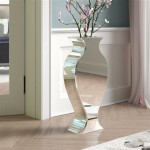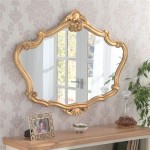```html
Choosing the Right Glue for Affixing Mirrors to Wood
Affixing a mirror to a wooden surface presents a unique set of challenges. The ideal adhesive must not only provide a strong and durable bond, but also be chemically compatible with both the reflective backing of the mirror and the wood itself. Selecting the wrong adhesive can lead to mirror degradation, wood warping, or a bond that fails over time, resulting in a potentially dangerous situation. This article provides a comprehensive overview of the factors to consider when selecting a glue for this specific application, outlining several suitable adhesive options and detailing best practices for application to ensure a lasting and aesthetically pleasing result.
The success of adhering a mirror to wood hinges on understanding the differing properties of the two materials. Wood, a porous and often uneven substrate, expands and contracts with changes in humidity and temperature. Mirrors, composed of a thin layer of reflective metal (traditionally silver, now often aluminum) applied to glass, are rigid and impervious to moisture. The adhesive must be able to accommodate these disparate material characteristics while preventing chemical reactions that can damage the mirror's reflective layer. Furthermore, the weight of the mirror must be adequately supported by the adhesive bond to prevent detachment due to gravity or vibrations.
Before applying any adhesive, thorough preparation of both the wood and the mirror backing is paramount. The wooden surface should be clean, dry, and free of any loose particles, dust, or previous finishes. Sanding the wood lightly can improve adhesion by creating a slightly rough surface for the glue to grip. The mirror's backing should also be cleaned with a dry cloth to remove any dust or debris. Avoid using harsh chemicals or cleaning solutions on the mirror backing, as these can potentially damage the reflective coating.
Understanding Key Considerations for Adhesive Selection
Choosing the appropriate adhesive involves considering several critical properties to ensure a successful and long-lasting bond between the mirror and the wood. These properties include chemical compatibility, strength, flexibility, and curing time, each playing a crucial role in the overall performance of the adhesive.
Chemical Compatibility: This is arguably the most important factor. Many common adhesives contain solvents or chemicals that can react with the reflective coating on the back of the mirror, causing discoloration, etching, or even complete delamination of the reflective layer. Adhesives specifically formulated for mirror applications typically use a neutral pH and are free from solvents that can attack the mirror's backing. Always check the manufacturer's specifications to confirm that the adhesive is suitable for use with mirrors.
Strength and Load-Bearing Capacity: The adhesive must be strong enough to support the weight of the mirror. Consider the size and weight of the mirror and choose an adhesive with sufficient shear and tensile strength. For larger or heavier mirrors, a combination of adhesive and mechanical fasteners (such as screws or clips) may be necessary to provide adequate support and prevent sagging or detachment over time.
Flexibility: Wood is a dynamic material that expands and contracts with changes in humidity and temperature. A rigid adhesive can create stress points and ultimately fail as the wood moves. A flexible adhesive can accommodate these movements, maintaining the bond and preventing cracks or separation. Adhesives with some degree of elastomeric properties are generally preferred for this application.
Curing Time: Adhesives vary in their curing time, which is the amount of time required for the adhesive to fully harden and reach its maximum strength. Faster-curing adhesives can reduce the time needed for the project, but they may also require faster working speeds. Slower-curing adhesives may offer more time for adjustments and repositioning, but they require longer clamping or support to prevent the mirror from slipping during the curing process.
Suitable Adhesive Options for Mirror to Wood Applications
Several types of adhesives are commonly used for adhering mirrors to wood, each with its own advantages and disadvantages. The best choice will depend on the specific requirements of the project, including the size and weight of the mirror, the type of wood used, and the desired curing time.
Mirror Mastics: These are specifically formulated for adhering mirrors and typically offer excellent adhesion, chemical compatibility, and flexibility. They are available in cartridges for use with a caulking gun. Look for mastics that are labeled as being "mirror safe" or "mirror adhesive." These products are specifically designed to avoid damaging the reflective coating.
Construction Adhesives: Some high-quality construction adhesives can be used for mirror applications, but it is crucial to verify their compatibility with mirrors. Look for construction adhesives that are solvent-free, low-VOC (volatile organic compounds), and specifically recommended for bonding mirrors to other materials. Check the product specifications carefully to ensure it will not damage the mirror's backing.
Polyurethane Adhesives: Polyurethane adhesives are known for their strong adhesion and flexibility. They are moisture-curing, meaning they require moisture to fully cure, which can be beneficial in humid environments. However, some polyurethane adhesives can expand during curing, which may not be desirable for all mirror applications. Again, ensure the specific polyurethane adhesive is mirror-safe.
Silicone Adhesives: While silicone adhesives are often used for sealing and waterproofing, certain types can also be used for bonding mirrors. However, it's vital to choose a neutral-cure silicone, as acidic-cure silicones can corrode the mirror's backing. Neutral-cure silicones are generally marked as "neutral cure" or "non-corrosive." Silicone can be a good choice if a very flexible bond is needed.
Double-Sided Adhesive Tape: For smaller, lightweight mirrors, high-strength double-sided adhesive tape designed for mirrors can be an option. This tape provides instant adhesion, eliminating the need for clamping. However, it is crucial to use a tape specifically designed for mirrors and to ensure that the surface is perfectly clean and smooth. The long-term holding power of double-sided tape may be less than that of liquid adhesives, especially in environments with fluctuating temperatures or humidity.
Best Practices for Application and Installation
Proper application techniques are essential for achieving a strong and durable bond between the mirror and the wood. Following these best practices will help ensure a successful outcome and prevent future problems.
Surface Preparation: As mentioned earlier, meticulous surface preparation is critical. Ensure both the wood and the mirror backing are clean, dry, and free of any contaminants. Sanding the wood lightly can improve adhesion. Use a clean, dry cloth to wipe the mirror backing.
Adhesive Application: Apply the adhesive in a consistent and even manner. For liquid adhesives, use a caulking gun or a trowel to apply the adhesive in vertical beads or a zig-zag pattern across the back of the mirror. Avoid applying adhesive to the edges of the mirror, as this can squeeze out and create a messy appearance. Distribute the adhesive evenly to ensure uniform support.
Positioning and Support: Carefully position the mirror onto the wooden surface. Once the mirror is in place, apply gentle pressure to ensure good contact between the adhesive and both surfaces. Use clamps, wedges, or temporary supports to hold the mirror in place while the adhesive cures. The amount of support needed will depend on the weight of the mirror and the curing time of the adhesive.
Curing Time: Allow the adhesive to fully cure according to the manufacturer's instructions. Avoid disturbing the mirror during the curing process. The curing time can vary from a few hours to several days, depending on the type of adhesive used. Ensure adequate ventilation during curing, especially when using adhesives with strong odors.
Mechanical Fasteners (Optional): For larger or heavier mirrors, consider supplementing the adhesive with mechanical fasteners such as screws or clips. These fasteners provide additional support and prevent the mirror from sagging or detaching over time. Choose fasteners that are compatible with both the wood and the mirror's backing. Predrill pilot holes to prevent splitting the wood.
Cleanup: Clean up any excess adhesive immediately with a damp cloth or the appropriate solvent recommended by the adhesive manufacturer. Allowing the adhesive to dry can make cleanup much more difficult. Be careful not to scratch the mirror surface during cleanup.
By carefully selecting the appropriate adhesive, preparing the surfaces properly, and following these best practices, you can achieve a strong, durable, and aesthetically pleasing bond between a mirror and a wooden surface, ensuring years of reliable performance.
```
4 Easy Steps To Glue Mirror Wood
Mirror Adhesive Adiseal Strong Glue For

How To Make A Diy Wood Frame Mirror With Mirrors Tea And Forget Me Nots

4 Easy Steps To Glue Mirror Wood
What Is The Best To Use Glue Mirrors A Wall Quora

Mirror Fix Sil 300ml Silicone Adhesive And Sealant For Mirrors Factory

Evo Stik Solvent Free Light Grey Mirror Adhesive 290ml Diy At B Q

Diy Driftwood Mirror Step By Tutorial Bird

Mirror Silicone Sealant Diy Bostik

How To Frame A Bathroom Mirror Diy Family Handyman








